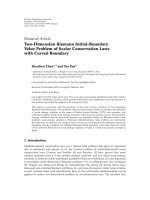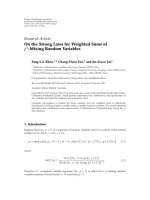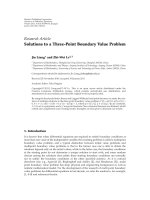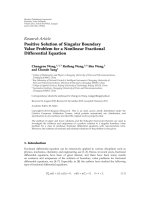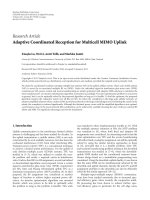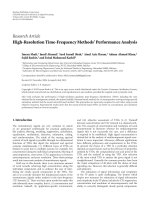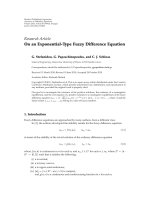Báo cáo hóa học: " Research Article Solutions to a Three-Point Boundary Value Problem" docx
Bạn đang xem bản rút gọn của tài liệu. Xem và tải ngay bản đầy đủ của tài liệu tại đây (535.85 KB, 20 trang )
Hindawi Publishing Corporation
Advances in Difference Equations
Volume 2011, Article ID 894135, 20 pages
doi:10.1155/2011/894135
Research Article
Solutions to a Three-Point Boundary Value Problem
Jin Liang
1
and Zhi-Wei Lv
2, 3
1
Department of Mathematics, Shanghai Jiao Tong University, Shanghai 200240, China
2
Department of Mathematics and Physics, Anyang Institute of Technology, Anyang, Henan 455000, China
3
Department of Mathematics, University of Science a nd Technology of China, Hefei, Anhui 230026, China
Correspondence should be addressed to Jin Liang,
Received 25 November 2010; Accepted 19 January 2011
Academic Editor: Toka Diagana
Copyright q 2011 J. Liang and Z W. Lv. This is an open access article distributed under the
Creative Commons Attribution License, which permits unrestricted use, distribution, and
reproduction in any medium, provided the original work is properly cited.
By using the fixed-point index theory and Leggett-Williams fixed-point theorem, we study the exis-
tence of multiple solutions to the three-point boundary value problem u
tatft, ut,u
t
0, 0 <t<1; u0u
00; u
1 − αu
ηλ,whereη ∈ 0, 1/2, α ∈ 1/2η, 1/η are constants,
λ ∈ 0, ∞ is a parameter, and a, f are given functions. New existence theorems are obtained, which
extend and complement some existing results. Examples are also given to illustrate our results.
1. Introduction
It is known that when differential equations are required to satisfy boundary conditions at
more than one value of the independent variable, the resulting problem is called a multipoint
boundary value problem, and a typical distinction between initial value problems a nd
multipoint boundary value problems is thatintheformercaseoneisabletoobtainthe
solutions depend only on the initial values, while in the latter case, the boundary conditions
at the starting point do not determine a unique solution to start with, and some random
choices among the solutions that satisfy these starting boundary conditions are normally
not to satisfy the boundary conditions at the other specified points.Asitisnoticed
elsewhere see, e.g., Agarwal 1, Bisplinghoff and Ashley 2, and Henderson 3,multi
point boundary value problem has deep physical and engineering background as well as
realistic mathematical model. For the development of the research of multi point boundary
value problems for differential equations in last decade, we refer the readers to, for example,
1, 4–9 and references therein.
2AdvancesinDifference Equations
In this paper, we study the existence of multiple solutions to the following three-point
boundary value problem for a class of third-order differential equations with inhomogeneous
three-point boundary values,
u
t
a
t
f
t, u
t
,u
t
0, 0 <t<1,
u
0
u
0
0,u
1
− αu
η
λ,
1.1
where η ∈ 0, 1/2, α ∈ 1/2η, 1/η, λ ∈ 0, ∞,anda, f are given functions. To the authors’
knowledge, few results on third-order differential equations with inhomogeneous three-point
boundary values can be found in the literature. Our purpose is to establish new existence
theorems for 1.1 which extend and complement some existing results.
Let X be an Banach space, and let Y be a cone in X. A mapping β is said to be a
nonnegative continuous concave functional on Y if β : Y → 0, ∞ is continuous and
β
tx
1 − t
y
≥ tβ
x
1 − t
β
y
,x,y∈ Y, t ∈
0, 1
. 1.2
Assume that
H
a ∈ C
0, 1
,
0, ∞
, 0 <
1
0
1 − s
sa
s
ds < ∞,
f ∈ C
0, 1
×
0, ∞
×
0, ∞
,
0, ∞
.
1.3
Define
max f
0
lim
v → 0
max
t∈0,1
sup
u∈0,∞
f
t, u, v
v
,
min f
0
lim
v → 0
min
t∈0,1
inf
u∈0,∞
f
t, u, v
v
,
max f
∞
lim
v → ∞
max
t∈0,1
sup
u∈0,∞
f
t, u, v
v
,
min f
∞
lim
v → ∞
min
t∈0,1
inf
u∈0,∞
f
t, u, v
v
.
1.4
This paper is organized in the following way. In Section 2, we present some lemmas,
which will be used in Section 3. The main results and proofs are given in Section 3. Finally, in
Section 4, we give some examples to illustrate our results.
Advances in Difference Equations 3
2. Lemmas
Let E C
1
0, 1 be a Banach Space with norm
u
1
max
u
,
u
, 2.1
where
u
max
t∈0,1
|
u
t
|
,
u
max
t∈0,1
u
t
.
2.2
It is not hard to see Lemmas 2.1 and 2.2.
Lemma 2.1. Let u ∈ C
1
0, 1 be the unique solution of 1.1.Then
u
t
1
0
G
t, s
a
s
f
s, u
s
,u
s
ds
αt
2
2
1 − αη
1
0
G
1
η, s
a
s
f
s, u
s
,u
s
ds
λt
2
2
1 − αη
,
2.3
where
G
t, s
1
2
⎧
⎨
⎩
2t − t
2
− s
s, s ≤ t,
1 − s
t
2
, t ≤ s,
G
1
t, s
∂G
t, s
∂t
⎧
⎨
⎩
1 − t
s, s ≤ t,
1 − s
t, t ≤ s.
2.4
Lemma 2.2. One has the following.
i 0 ≤ G
1
t, s ≤ 1 − ss, 1/2t
2
1 − ss ≤ Gt, s ≤ G1,s1/21 − ss.
ii G
1
t, s ≥ 1/4G
1
s, s1/41 − ss, for t ∈ 1/4, 3/4,s∈ 0, 1.
iii G
1
1/2,s ≥ 1/21 − ss, for s ∈ 0, 1.
Lemma 2.3. Let u ∈ C
1
0, 1 be the unique solution of 1.1.Thenut is nonnegative and satisfies
u
1
u
.
Proof. Let u ∈ C
1
0, 1 be the unique solution of 1.1.Thenitisobviousthatut is
nonnegative. By Lemmas 2.1 and 2.2, we have the following.
4AdvancesinDifference Equations
i For t ≤ η,
u
t
1
2
1 − αη
t
0
2ts − s
2
1 − αη
t
2
s
α − 1
a
s
f
s, u
s
,u
s
ds
η
t
t
2
1 − αη
t
2
s
α − 1
a
s
f
s, u
s
,u
s
ds
1
η
t
2
1 − s
a
s
f
s, u
s
,u
s
ds λt
2
,
u
t
1
2
1 − αη
t
0
2s
1 − αη
2ts
α − 1
a
s
f
s, u
s
,u
s
ds
η
t
2t
1 − αη
2ts
α − 1
a
s
f
s, u
s
,u
s
ds
1
η
2t
1 − s
a
s
f
s, u
s
,u
s
ds 2λt
,
2.5
that is, ut ≤ u
t.
ii For t ≥ η,
u
t
1
2
1 − αη
η
0
2ts − s
2
1 − αη
t
2
s
α − 1
a
s
f
s, u
s
,u
s
ds
t
η
2ts − s
2
1 − αη
t
2
αη − s
a
s
f
s, u
s
,u
s
ds
1
t
t
2
1 − s
a
s
f
s, u
s
,u
s
ds λt
2
,
u
t
1
2
1 − αη
η
0
2s
1 − αη
2ts
α − 1
a
s
f
s, u
s
,u
s
ds
t
η
2s
1 − αη
2t
αη − s
a
s
f
s, u
s
,u
s
ds
1
t
2t
1 − s
a
s
f
s, u
s
,u
s
ds 2λt
.
2.6
Advances in Difference Equations 5
On the other hand, for η ≤ s ≤ t,wehave
2s
1 − αη
2t
αη − s
−
2ts − s
2
1 − αη
t
2
αη − s
αη
t − s
2 s − t
s
1 − t
2 − t
s
s − t
αη
t − s
2 s − t −
s
αη
s
1 − t
2 − t
.
2.7
Since α ∈ 1/2η, 1/η,
2s
1 − αη
2t
αη − s
≥
2ts − s
2
1 − αη
t
2
αη − s
. 2.8
So, ut ≤ u
t. Therefore, ut ≤ u
t,whichmeans
u
≤
u
,
u
1
u
. 2.9
The proof is completed.
Lemma 2.4. Let u ∈ C
1
0, 1 be the unique solution of 1.1.Then
min
t∈1/4,3/4
u
t
≥
1
4
u
1
.
2.10
Proof. From 2.3, it follows that
u
t
1
0
G
1
t, s
a
s
f
s, u
s
,u
s
ds
αt
1 − αη
1
0
G
1
η, s
a
s
f
s, u
s
,u
s
ds
λt
1 − αη
≤
1
0
1 − s
sa
s
f
s, u
s
,u
s
ds
α
1 − αη
1
0
G
1
η, s
a
s
f
s, u
s
,u
s
ds
λ
1 − αη
.
2.11
Hence,
u
1
u
≤
1
0
1 − s
sa
s
f
s, u
s
,u
s
ds
α
1 − αη
1
0
G
1
η, s
a
s
f
s, u
s
,u
s
ds
λ
1 − αη
.
2.12
6AdvancesinDifference Equations
By Lemmas 2.2 and 2.3,weget,foranyt ∈ 1/4, 3/4,
min
t∈1/4,3/4
u
t
min
t∈1/4,3/4
1
0
G
1
t, s
a
s
f
s, u
s
,u
s
ds
αt
1 − αη
1
0
G
1
η, s
a
s
f
s, u
s
,u
s
ds
λt
1 − αη
≥
1
4
1
0
1 − s
sa
s
f
s, u
s
,u
s
ds
α
1 − αη
1
0
G
1
η, s
a
s
f
s, u
s
,u
s
ds
λ
1 − αη
.
2.13
Thus,
min
t∈1/4,3/4
u
t
≥
1
4
u
1
.
2.14
Define a cone by
K
u ∈ E : u ≥ 0, min
t∈1/4,3/4
u
t
≥
1
4
u
1
.
2.15
Set
K
r
{
u ∈ K :
u
1
<r
}
,∂K
r
{
u ∈ K :
u
1
r
}
,r>0,
K
r
{
u ∈ K :
u
1
≤ r
}
,K
β, r, s
u ∈ K : r ≤ β
u
,
u
1
≤ s
,s>r>0.
2.16
Define an operator T by
Tu
t
1
0
G
t, s
a
s
f
s, u
s
,u
s
ds
αt
2
2
1 − αη
1
0
G
1
η, s
a
s
f
s, u
s
,u
s
ds
λt
2
2
1 − αη
.
2.17
Lemma 2.1 implies that 1.1 has a solution u ut if and only if u is a fixed point of T.
From Lemmas 2.1 and 2.2 and the Ascoli-Arzela theorem, the following follow.
Lemma 2.5. The operator defined in 2.17 is completely continuous and satisfies TK ⊂ K.
Advances in Difference Equations 7
Theorem 2.6 see 10. Let E be a real Banach Space, let K ⊂ E be a c one, and Ω
r
{u ∈ K : u≤
r}. Let operator T : K∩Ω
r
→ K be completely continuous and satisfy Tx
/
x, for all x ∈ ∂Ω
r
.Then
i if Tx≤x, for all x ∈ ∂Ω
r
,theniT, Ω
r
,K1,
ii if Tx≥x, for all x ∈ ∂Ω
r
,theniT, Ω
r
,K0.
Theorem 2.7 see 8. Let T :
P
c
→ P
c
be a completely continuous operator and β a nonnegative
continuous concave functional on P such that βx ≤x for all x ∈
P
c
. Suppose that there exist
0 <d
0
<a
0
<b
0
≤ c such that
a {x ∈ Pβ, a
0
,b
0
: βx >a
0
}
/
∅ and βTx >a
0
for x ∈ Pβ, a
0
,b
0
,
b Tx <d
0
for x≤d
0
,
c βTx >a
0
for x ∈ Pβ, a
0
,c with Tx >b
0
.
Then, T has at least three fixed points x
1
,x
2
, and x
3
in P
c
satisfying
x
1
<d
0
,a
0
<β
x
2
,
x
3
>d
0
,β
x
3
<a
0
. 2.18
3. Main Results
In this section, we give new existence theorem about two positive solutions or three positive
solutions for 1.1.
Write
Λ
1
1
0
1 − s
sa
s
ds
α
1 − αη
1
0
G
1
η, s
a
s
ds
−1
,
Λ
2
3/4
1/4
1 − s
sa
s
ds
α
1 − αη
3/4
1/4
G
1
η, s
a
s
ds
−1
.
3.1
Theorem 3.1. Assume that
H
1
min f
0
min f
∞
∞;
H
2
there exists a constant ρ
1
> 0 such that ft, u, v ≤ 1/2Λ
1
ρ
1
,fort ∈ 0, 1, u ∈ 0,ρ
1
and v ∈ 0,ρ
1
.
Then, the problem 1.1 has at least two positive solutions u
1
and u
2
such that
0 <
u
1
1
<ρ
1
<
u
2
1
, 3.2
for λ small enough.
Proof. Since
min f
0
lim
v → 0
min
t∈0,1
inf
u∈0,∞
f
t, u, v
v
∞,
3.3
8AdvancesinDifference Equations
there is ρ
0
∈ 0,ρ
1
such that
f
t, u, v
≥ 8Λ
2
v, for t ∈
0, 1
,u∈
0, ∞
,v∈
0,ρ
0
, Λ
2
> 0. 3.4
Let
Ω
ρ
0
u ∈ K :
u
1
<ρ
0
. 3.5
Then, for any u ∈ ∂Ω
ρ
0
, it follows from Lemmas 2.2 and 2.3 and 3.4 that
Tu
1
2
1
0
G
1
1
2
,s
a
s
f
s, u
s
,u
s
ds
α
2
1 − αη
1
0
G
1
η, s
a
s
f
s, u
s
,u
s
ds
λ
2
1 − αη
≥
1
0
G
1
1
2
,s
a
s
f
s, u
s
,u
s
ds
α
2
1 − αη
1
0
G
1
η, s
a
s
f
s, u
s
,u
s
ds
≥
1
2
3/4
1/4
1 − s
sa
s
8Λ
2
u
s
ds
α
2
1 − αη
3/4
1/4
G
1
η, s
a
s
8Λ
2
u
s
ds
≥ 4Λ
2
3/4
1/4
1 − s
sa
s
ds
α
2
1 − αη
3/4
1/4
G
1
η, s
a
s
ds
1
4
u
1
1
u
1
.
3.6
Hence,
Tu
≥
u
1
. 3.7
So
Tu
1
≥
u
1
, ∀u ∈ ∂Ω
ρ
0
. 3.8
By Theorem 2.6,wehave
i
T, Ω
ρ
0
,K
0. 3.9
On the other hand, since
min f
∞
lim
v → ∞
min
t∈0,1
inf
u∈0,∞
f
t, u, v
v
∞,
3.10
Advances in Difference Equations 9
there exist ρ
∗
0
, ρ
∗
0
>ρ
1
such that
f
t, u, v
≥ 8Λ
2
v, for t ∈
0, 1
,u∈
0, ∞
,v≥
1
4
ρ
∗
0
.
3.11
Let Ω
ρ
∗
0
{u ∈ K : u
1
<ρ
∗
0
}. Then, by a argument similar to that above, we obtain
Tu
1
≥
u
1
, ∀u ∈ ∂Ω
ρ
∗
0
.
3.12
By Theorem 2.6,
i
T, Ω
ρ
∗
0
,K
0. 3.13
Finally, let Ω
ρ
1
{u ∈ K : u
1
<ρ
1
},andletλ satisfy 0 <λ≤ 1/21 − αηρ
1
for any
u ∈ ∂Ω
ρ
1
. Then, H
2
implies
Tu
t
1
0
G
1
t, s
a
s
f
s, u
s
,u
s
ds
αt
1 − αη
1
0
G
1
η, s
a
s
f
s, u
s
,u
s
ds
λt
1 − αη
≤
1
0
1 − s
sa
s
1
2
Λ
1
ρ
1
ds
α
1 − αη
1
0
G
1
η, s
a
s
1
2
Λ
1
ρ
1
ds
λ
1 − αη
≤
1
2
Λ
1
1
0
1 − s
sa
s
ds
α
1 − αη
1
0
G
1
η, s
a
s
ds
ρ
1
1/2
1 − αη
ρ
1
1 − αη
1
2
ρ
1
1
2
ρ
1
u
1
,
3.14
which means that Tu
≤u
1
.Thus,Tu
1
≤u
1
,forallu ∈ ∂Ω
ρ
1
.
Using Theorem 2.6,weget
i
T, Ω
ρ
1
,K
1. 3.15
From 3.9–3.15 and ρ
0
<ρ
1
<ρ
∗
0
, it follows that
i
T, Ω
ρ
∗
0
\ Ω
ρ
1
,K
−1,i
T, Ω
ρ
1
\ Ω
ρ
0
,K
1. 3.16
10 Advances in Difference Equations
Therefore, T has fixed point u
1
∈ Ω
ρ
1
\ Ω
ρ
0
andfixedpointu
2
∈ Ω
ρ
∗
0
\ Ω
ρ
1
. Clearly, u
1
, u
2
are
both positive solutions of the problem 1.1 and
0 <
u
1
1
<ρ
1
<
u
2
1
. 3.17
The proof of Theorem 3.1 is completed.
Theorem 3.2. Assume that
H
3
max f
0
max f
∞
0;
H
4
there exists a constant ρ
2
> 0 such that ft, u, v ≥ 2Λ
2
ρ
2
,fort ∈ 0, 1,u ∈ 0,ρ
2
and
v ∈ 1/4ρ
2
,ρ
2
.
Then, the problem 1.1 has at least two positive solutions u
1
and u
2
such that
0 <
u
1
1
<ρ
2
<
u
2
1
3.18
for λ small enough.
Proof. By
max f
0
lim
v → 0
max
t∈0,1
sup
u∈0,∞
f
t, u, v
v
0,
3.19
we see that there exists ρ
∗
∈ 0,ρ
2
such that
f
t, u, v
≤
1
2
Λ
1
v, for t ∈
0, 1
,u∈
0, ∞
,v∈
0,ρ
∗
.
3.20
Put
Ω
ρ
∗
u ∈ K :
u
1
<ρ
∗
, 3.21
and let λ satisfy
0 <λ≤
1
2
1 − αη
ρ
∗
.
3.22
Then Lemmas 2.2 and 2.3 and 3.20 implies that for any u ∈ ∂Ω
ρ
∗
,
Tu
t
1
0
G
1
t, s
a
s
f
s, u
s
,u
s
ds
αt
1 − αη
1
0
G
1
η, s
a
s
f
s, u
s
,u
s
ds
λt
1 − αη
Advances in Difference Equations 11
≤
1
0
1 − s
sa
s
1
2
Λ
1
u
s
ds
α
1 − αη
1
0
G
1
η, s
a
s
1
2
Λ
1
u
s
ds
λ
1 − αη
≤
1
2
Λ
1
1
0
1 − s
sa
s
ds
α
1 − αη
1
0
G
1
η, s
a
s
ds
u
1
1 − αη
ρ
∗
2
1 − αη
≤
1
2
u
1
1
2
ρ
∗
u
1
.
3.23
So Tu
≤u
1
.Hence,Tu
1
≤u
1
,forallu ∈ ∂Ω
ρ
∗
.
Applying Theorem 2.6,wehave
i
T, Ω
ρ
∗
,K
1. 3.24
Next, by
max f
∞
lim
v → ∞
max
t∈0,1
sup
u∈0,∞
f
t, u, v
v
0,
3.25
we know that there exists r
0
>ρ
2
such that
f
t, u, v
≤
1
2
Λ
1
v, for t ∈
0, 1
,u∈
0, ∞
,v≥ r
0
.
3.26
Case 1. max
t∈0,1
ft, u, v is unbounded.
Define a function f
∗
: 0, ∞ → 0, ∞ by
f
∗
ρ
max
f
t, u, v
: t ∈
0, 1
,u,v∈
0,ρ
. 3.27
Clearly, f
∗
is nondecreasing and lim
ρ → ∞
f
∗
ρ/ρ 0, and
f
∗
ρ
≤
1
2
Λ
1
ρ, for ρ>r
0
.
3.28
Taking ρ
∗
≥ max{2r
0
, 2λ/1 − αη, 2ρ
2
}, it follows from 3.26–3.28 that
f
t, u, v
≤ f
∗
ρ
∗
≤
1
2
Λ
1
ρ
∗
, for t ∈
0, 1
,u,v∈
0,ρ
∗
.
3.29
12 Advances in Difference Equations
By Lemmas 2.2 and 2.3 and 3.28,wehave
Tu
t
1
0
G
1
t, s
a
s
f
s, u
s
,u
s
ds
αt
1 − αη
1
0
G
1
η, s
a
s
f
s, u
s
,u
s
ds
λt
1 − αη
≤
1
0
1 − s
sa
s
1
2
Λ
1
ρ
∗
ds
α
1 − αη
1
0
G
1
η, s
a
s
1
2
Λ
1
ρ
∗
ds
λ
1 − αη
≤
1
2
Λ
1
1
0
1 − s
sa
s
ds
α
1 − αη
1
0
G
1
η, s
a
s
ds
ρ
∗
ρ
∗
2
ρ
∗
.
3.30
So Tu
≤ρ
∗
,andthenTu
1
≤ ρ
∗
.
Case 2. max
t∈0,1
ft, u, v is bounded.
In this case, there exists an M>0suchthat
max
t∈0,1
f
t, u, v
≤ M, for t ∈
0, 1
,u,v∈
0, ∞
.
3.31
Choosing ρ
∗
≥ max{2ρ
2
, 2M/Λ
1
, 2λ/1 − αη}, we see by Lemmas 2.2 and 2.3 and 3.31 that
Tu
t
1
0
G
1
t, s
a
s
f
s, u
s
,u
s
ds
αt
1 − αη
1
0
G
1
η, s
a
s
f
s, u
s
,u
s
ds
λt
1 − αη
≤ M
1
0
1 − s
sa
s
ds
α
1 − αη
1
0
G
1
η, s
a
s
ds
ρ
∗
2
≤
ρ
∗
2
ρ
∗
2
ρ
∗
,
3.32
which implies Tu
≤ρ
∗
,andthenTu
1
≤ ρ
∗
.
Therefore, in both cases, taking
Ω
ρ
∗
u ∈ K :
u
1
<ρ
∗
, 3.33
Advances in Difference Equations 13
we get
Tu
1
≤
u
1
, ∀u ∈ ∂Ω
ρ
∗
. 3.34
By Theorem 2.6,wehave
i
T, Ω
ρ
∗
,K
1. 3.35
Finally, put Ω
ρ
2
{u ∈ K : u
1
<ρ
2
}.ThenH
4
implies that
Tu
1
2
1
0
G
1
1
2
,s
a
s
f
s, u
s
,u
s
ds
α
2
1 − αη
1
0
G
1
η, s
a
s
f
s, u
s
,u
s
ds
λ
2
1 − αη
≥
3/4
1/4
1
2
1 − s
sa
s
2Λ
2
ρ
2
ds
α
2
1 − αη
3/4
1/4
G
1
η, s
a
s
2Λ
2
ρ
2
ds
≥ Λ
2
ρ
2
3/4
1/4
1 − s
sa
s
ds
α
1 − αη
3/4
1/4
G
1
η, s
a
s
ds
ρ
2
,
3.36
that is, Tu
≥ρ
2
,andthenTu
1
≥u
1
,forallu ∈ ∂Ω
ρ
2
.ByvirtueofTheorem2.6,wehave
i
T, Ω
ρ
2
,K
0. 3.37
From 3.24, 3.35, 3.37,andρ
∗
<ρ
2
<ρ
∗
, it follows that
i
T, Ω
ρ
∗
\ Ω
ρ
2
,K
1,i
T, Ω
ρ
2
\ Ω
ρ
∗
,K
−1. 3.38
Hence, T has fixed point u
1
∈ Ω
ρ
2
\ Ω
ρ
∗
and fixed point u
2
∈ Ω
ρ
∗
\ Ω
ρ
2
. Obviously, u
1
, u
2
are
both positive solutions of the problem 1.1 and
0 <
u
1
1
<ρ
2
<
u
2
1
. 3.39
The proof of Theorem 3.2 is completed.
Theorem 3.3. Let there exist d
0
, a
0
, b
0
,andc with
0 <d
0
<a
0
< 32a
0
<b
0
≤ c, 3.40
14 Advances in Difference Equations
such that
f
t, u, v
≤
1
4
Λ
1
d
0
,t∈
0, 1
,u∈
0,d
0
,v∈
0,d
0
,
3.41
f
t, u, v
≥ 35Λ
2
a
0
,t∈
0, 1
,u∈
a
0
,b
0
,v∈
a
0
,b
0
, 3.42
f
t, u, v
≤
1
2
Λ
1
c, t ∈
0, 1
,u∈
0,c
,v∈
0,c
.
3.43
Then problem 1.1 has at least three positive solutions u
1
, u
2
, u
3
satisfying
u
1
1
<d
0
,a
0
<β
u
2
,
u
3
1
>d
0
,β
u
3
<a
0
, 3.44
for λ ≤ 1/21 − αηd
0
.
Proof. Let
β
u
min
t∈1/4,3/4
|
u
t
|
,u∈ K.
3.45
Then, β is a nonnegative continuous concave functional on K and βu ≤u
1
for each u ∈ K.
Let u be in
K
c
.Equation3.43 implies that
Tu
t
1
0
G
1
t, s
a
s
f
s, u
s
,u
s
ds
αt
1 − αη
1
0
G
1
η, s
a
s
f
s, u
s
,u
s
ds
λt
1 − αη
≤
1
2
Λ
1
1
0
1 − s
sa
s
ds
α
1 − αη
1
0
G
1
η, s
a
s
ds
c
1/2
1 − αη
c
1 − αη
c.
3.46
Hence, Tu
1
≤ c. This means that T : K
c
→ K
c
.
Take
u
0
t
1
2
a
0
b
0
,t∈
0, 1
. 3.47
Then,
u
0
∈
u ∈ K
β, a
0
,b
0
: β
u
>a
0
/
∅. 3.48
Advances in Difference Equations 15
By 3.42,wehave,foranyu ∈ Kβ, a
0
,b
0
,
β
Tu
min
t∈1/4,3/4
1
0
G
t, s
a
s
f
s, u
s
,u
s
ds
αt
2
2
1 − αη
1
0
G
1
η, s
a
s
f
s, u
s
,u
s
ds
λt
2
2
1 − αη
≥ min
t∈1/4,3/4
1
0
1
2
t
2
s
1 − s
a
s
f
s, u
s
,u
s
ds
αt
2
2
1 − αη
1
0
G
1
η, s
a
s
f
s, u
s
,u
s
ds
λt
2
2
1 − αη
≥
3/4
1/4
1
2
1
4
2
s
1 − s
a
s
35Λ
2
a
0
ds
α
2
1 − αη
1
4
2
3/4
1/4
G
1
η, s
a
s
35Λ
2
a
0
ds
35
32
a
0
>a
0
.
3.49
Therefore, a in Theorem 2.7 holds.
By 3.41,weseethatforanyu
1
≤ d
0
Tu
t
1
0
G
1
t, s
a
s
f
s, u
s
,u
s
ds
αt
1 − αη
1
0
G
1
η, s
a
s
f
s, u
s
,u
s
ds
λt
1 − αη
≤
1
0
1 − s
sa
s
1
4
Λ
1
d
0
ds
α
1 − αη
1
0
G
1
η, s
a
s
1
4
Λ
1
d
0
ds
1/2
1 − αη
d
0
1 − αη
3
4
d
0
.
3.50
So, Tu
1
≤ 3/4d
0
<d
0
. This means that b of Theorem 2.7 holds.
Moreover, for any u ∈ Kβ, a
0
,c with Tu
1
>b
0
,wehave
β
Tu
min
t∈1/4,3/4
1
0
G
t, s
a
s
f
s, u
s
,u
s
ds
αt
2
2
1 − αη
1
0
G
1
η, s
a
s
f
s, u
s
,u
s
ds
λt
2
2
1 − αη
16 Advances in Difference Equations
≥ min
t∈1/4,3/4
1
0
1
2
t
2
1 − s
sa
s
f
s, u
s
,u
s
ds
αt
2
2
1 − αη
1
0
G
1
η, s
a
s
f
s, u
s
,u
s
ds
λt
2
2
1 − αη
≥
1
2
×
1
16
1
0
1 − s
sa
s
f
s, u
s
,u
s
ds
α
1 − αη
1
0
G
1
η, s
a
s
f
s, u
s
,u
s
ds
λ
1 − αη
≥
1
32
1
0
G
1
t, s
a
s
f
s, u
s
,u
s
ds
α
1 − αη
1
0
G
1
η, s
a
s
f
s, u
s
,u
s
ds
λ
1 − αη
≥
1
32
1
0
G
1
t, s
a
s
f
s, u
s
,u
s
ds
αt
1 − αη
1
0
G
1
η, s
a
s
f
s, u
s
,u
s
ds
λt
1 − αη
1
32
Tu
t
,
3.51
which implies
β
Tu
≥
1
32
Tu
1
>
1
32
b
0
>a
0
.
3.52
So, c in Theorem 2.7 holds. Thus, by Theorem 2.7, we k now that t he operator T has at least
three positive fixed points u
1
,u
2
,u
3
∈ K
c
satisfying
u
1
1
<d
0
,a
0
<β
u
2
,
u
3
1
>d
0
,β
u
3
<a
0
. 3.53
4. Examples
In this section, we give three examples to illustrate our results.
Example 4.1. Consider the problem
u
t
1
10
2
t−1
1 2
−ut
u
t
1/2
u
t
2
0, 0 <t<1,
u
0
u
0
0,u
1
− u
1
2
λ,
4.1
Advances in Difference Equations 17
where η 1/2, α 1. Set
a
t
1
10
,f
t, u
t
,u
t
2
t−1
1 2
−ut
u
t
1/2
u
t
2
.
4.2
Then,
min f
0
min f
∞
∞. 4.3
So, the condition H
1
is satisfied. Observe
Λ
1
1
0
1 − s
sa
s
ds
α
1 − αη
1
0
G
1
η, s
a
s
ds
−1
1
0
1 − s
sa
s
ds
α
1 − αη
η
0
1 − η
sa
s
ds
1
η
η
1 − s
a
s
ds
−1
1
0
1 − s
s
1
10
ds
1
1 −
1/2
1/2
0
1 −
1
2
s
1
10
ds
1
1/2
1
2
1 − s
1
10
ds
−1
24.
4.4
Taking
ρ
1
4, for t ∈
0, 1
,u∈
0,ρ
1
,v∈
0,ρ
1
, 4.5
we have
f
t, u, v
≤
1 1
2 16
36 9ρ
1
<
1
2
Λ
1
ρ
1
12ρ
1
.
4.6
Thus, condition H
2
is satisfied.
Therefore, by Theorem 3.1,theproblem4.1 has at least two positive solutions u
1
and
u
2
such that
0 <
u
1
1
< 4 <
u
2
1
, 4.7
for
0 <λ≤
1
2
1 − αη
ρ
1
1
4
ρ
1
.
4.8
18 Advances in Difference Equations
Example 4.2. Consider the problem
u
t
2 × 5
8
1 t
2 sin u
t
u
t
2
5
−u
t
0, 0 <t<1,
u
0
u
0
0,u
1
− u
1
2
λ,
4.9
where η 1/2, α 1. Set
a
t
2,f
t, u, v
5
8
1 t
2 sin u
t
u
t
2
5
−u
t
.
4.10
Then,
max f
0
max f
∞
0, 4.11
that is, the condition H
3
is satisfied. Moreover,
Λ
2
3/4
1/4
1 − s
sa
s
ds
α
1 − αη
3/4
1/4
G
1
η, s
a
s
ds
−1
3/4
1/4
1 − s
s2ds
1
1 −
1/2
1/2
1/4
1 −
1
2
s2ds
3/4
1/2
1
2
1 − s
2ds
−1
48
29
.
4.12
Taking
ρ
2
8, for t ∈
0, 1
,u∈
0,ρ
2
,v∈
1
4
ρ
2
,ρ
2
, 4.13
we get
f
t, u, v
≥ 5
8
8
2
5
−8
8
2
8ρ
2
> 2Λ
2
ρ
2
96
29
ρ
2
.
4.14
Thus, condition H
4
is satisfied.
Consequently, by Theorem 3.2,weseethatfor
0 <λ≤
1
2
1 − αη
ρ
∗
≤
1
4
ρ
2
,
4.15
the problem 4.9 has at least two positive solutions u
1
and u
2
such that
0 <
u
1
1
< 8 <
u
2
1
. 4.16
Advances in Difference Equations 19
Example 4.3. For the problem 1.1,takeη 1/2, α 1, and at2. Then,
Λ
1
6
5
, Λ
2
48
29
.
4.17
Let
d
0
1,a
0
2,b
0
99,c
1425
6
,
f
t, u, v
⎧
⎪
⎪
⎪
⎪
⎪
⎪
⎪
⎪
⎪
⎪
⎪
⎪
⎪
⎪
⎪
⎪
⎪
⎪
⎪
⎪
⎪
⎪
⎨
⎪
⎪
⎪
⎪
⎪
⎪
⎪
⎪
⎪
⎪
⎪
⎪
⎪
⎪
⎪
⎪
⎪
⎪
⎪
⎪
⎪
⎪
⎩
1 − t
10
t
2
u
10
tv
10
,t∈
0, 1
,u∈
0, 1
,v∈
0, 1
.
1 − t
10
t
2
10
t
10
70
u − 1
70
v − 1
,t∈
0, 1
,u∈
1, 2
,v∈
1, 2
,
1 − t
10
t
2
10
t
10
140,t∈
0, 1
,u∈
2, 99
,v∈
2, 99
,
1 − t
10
t
2
10
t
10
140
2
sin
2v
u − 99
v − 99
1 t
2
u
2
,t∈
0, 1
,u∈
99, ∞
,v∈
99, ∞
.
4.18
Then,
f
t, u, v
1 − t
10
t
2
u
10
tv
10
≤
1
10
1
10
1
10
3
10
1
4
Λ
1
d
0
,t∈
0, 1
,u∈
0, 1
,v∈
0, 1
,
f
t, u, v
1 − t
10
t
2
10
t
10
140 ≥ 140 > 35Λ
2
a
0
35 ×
48
29
× 2,t∈
0, 1
,u∈
2, 99
,v∈
2, 99
,
f
t, u, v
1 − t
10
t
2
10
t
10
140 2
sin
2v
u − 99
v − 99
1 t
2
u
2
≤
3
10
140 2
1423
10
<
1
2
Λ
1
c
1
2
×
6
5
×
1425
6
,t∈
0, 1
,u∈
99, ∞
,v∈
99, ∞
,
4.19
which implies
f
t, u, v
<
1
2
Λ
1
c, t ∈
0, 1
,u∈
0,c
,v∈
0,c
.
4.20
20 Advances in Difference Equations
That is, the conditions of Theorem 3.3 are satisfied. Consequently, the problem 1.1 has at
least three positive solutions u
1
,u
2
,u
3
∈ K
c
for
λ ≤
1
2
1 − αη
d
0
1
4
4.21
satisfying
u
1
1
< 1, 2 <β
u
2
,
u
3
1
> 1,β
u
3
< 2. 4.22
Acknowledgments
This paper was supported partially by the NSF of China 10771202 and the Specialized
Research Fund for the Doctoral Program of Higher Education of China 2007035805.
References
1 R. P. Agarwal, Focal Boundary Value Problems for Differential and Difference Equations, vol. 436 of
Mathematics a nd Its Applications, Kluwer Academic Publishers, Dordr echt, The Netherlands, 1998.
2 R. L. Bisplinghoff and H. Ashley, Principles of Aeroelasticity, Dover Publications, Mineola, NY, USA,
2002.
3 J. Henderson, Ed., Boundary Value Problems for Functional-Differential Equations, World Scientific, River
Edge, NJ, USA, 1995.
4 D. R. Anderson, “Green’s function for a third-order generalized right focal problem,” Journal of
Mathematical Analysis and Applications, vol. 288, no. 1, pp. 1–14, 2003.
5 R. I. Avery and A. C. Peterson, “Three positive fixed points of nonlinear operators on ordered Banach
spaces,” Computers & Mathematics with Applications, vol. 42, no. 3–5, pp. 313–322, 2001.
6 A. Boucherif and N. Al-Malki, “Nonlinear three-point third-order boundary value problems,” Applied
Mathematics a nd Computation, vol. 190, no. 2, pp. 1168–1177, 2007.
7 G. L. Karakostas, K. G. Mavridis, and P. C. Tsamatos, “Triple solutions for a nonlocal functional
boundary value problem by Leggett-Williams theorem,” Applicable Analysis, vol. 83, no. 9, pp. 957–
970, 2004.
8 R. W. Leggett and L. R. Williams, “Multiple positive fixed points of nonlinear operators on ordered
Banach spaces,” Indiana University Mathematics Journal, vol. 28, no. 4, pp. 673–688, 1979.
9 Y. Sun, “Positive solutions for third-order three-point nonhomogeneous boundary value problems,”
Applied Mathematics Letters, vol. 22, no. 1, pp. 45–51, 2009.
10 D. J. Guo and V. Lakshmikantham, Nonlinear Problems in Abstract Cones, vol. 5 of Notes and Reports in
Mathematics in Science and Engineering, Academic Press, Boston, Mass, USA, 1988.
